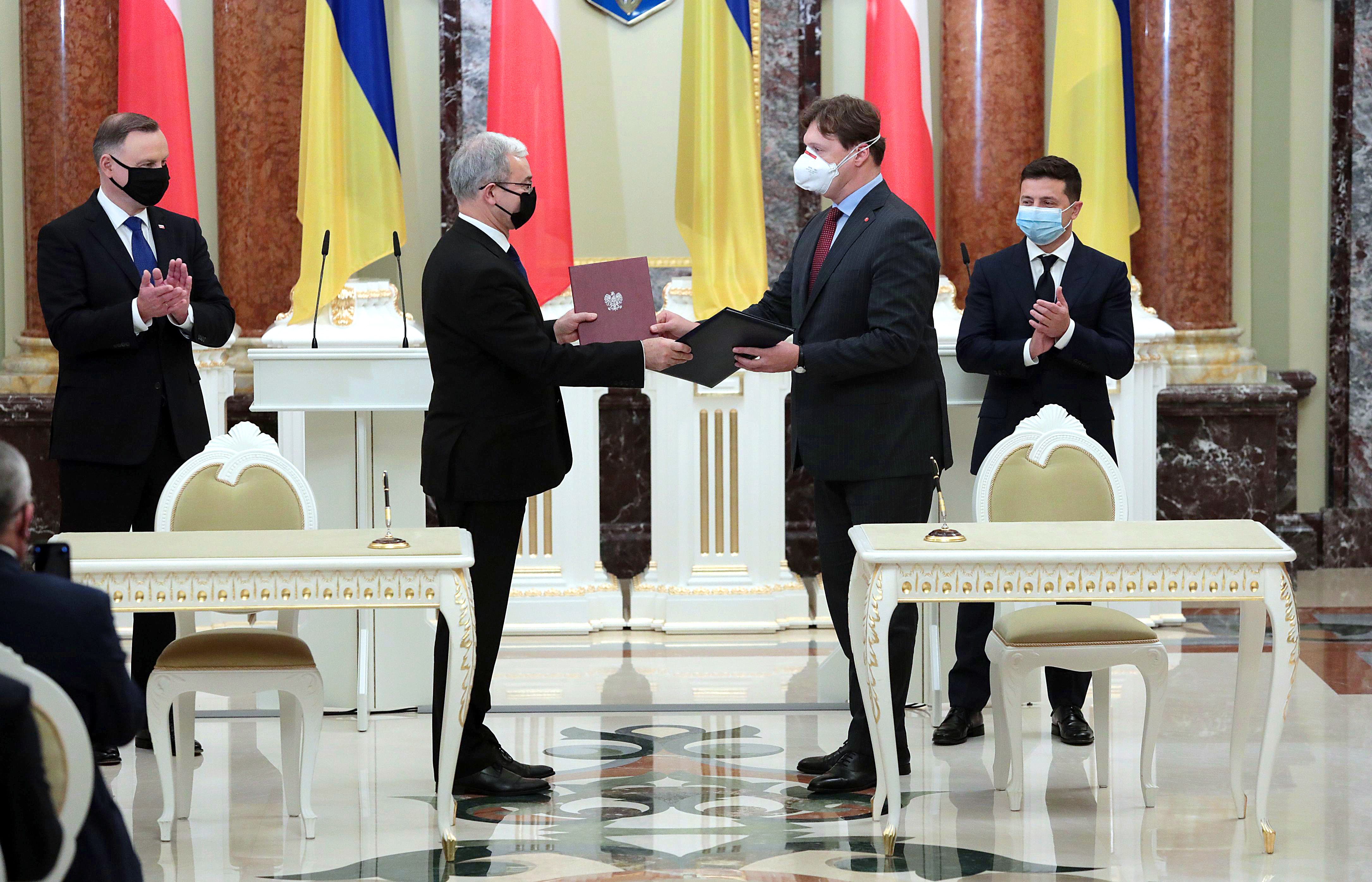Perspectives on Polish-Ukrainian Cooperation in the Natural Gas Sector

Ukrainian Gas Sector
The country has been one of Europe’s biggest gas consumers. In 2013, before the Russian aggression, Ukraine consumed around 50 billion cubic metres (bcm). To compare, in the EU, only Germany, the UK, and Italy consumed more that year. Around 28 bcm of gas was almost entirely from Russia (only Germany and Turkey imported more Russian gas). These imports gave Russia political leverage and strengthened the position of Ukrainian oligarchs involved in gas deals with that country, such as Dmytro Firtash, who controls gas-distribution companies in Ukraine. At the same time, corruption schemes in gas distribution stalled the efforts to reduce the economy’s energy intensity.
By 2019, gas consumption had decreased to 30 bcm, and from November 2015 gas imports from Russia were completely halted and replaced by imports from the EU (11 bcm last year). This was possible thanks to investments in gas links with EU countries and other deals. This radical decrease in consumption was caused by Ukraine’s losing control over part of its territory after Russia’s illegal annexation of Crimea and aggression in Donbas, as well as the economic crisis of 2014-15, along with the reduction of energy intensity—a 10% decrease between 2014 and 2017. To get access to international credits and enjoy closer cooperation with the EU (especially after the Russian aggression), Ukraine pushed forward its gas-sector reforms, implementing EU regulations that improve transparency, among other benefits.
Opportunities for Polish-Ukrainian Cooperation
Poland and Ukraine are cooperating more and more actively in the gas trade. In 2019, 1.4 bcm of gas was shipped from Poland to Ukraine (amounting to about 13% of Ukrainian imports), of which the Polish state firm PGNiG sold 544 million cubic metres (mcm). In addition, PGNiG provided gas during the winter of 2018 when Gazprom refused to supply Ukraine after losing an arbitration with Naftogaz. The expansion of the Polish-Ukrainian interconnector’s capacity from 2 bcm to 6.6 bcm and diversification of supply routes to Poland created additional opportunities to increase volumes. The terminal in Świnoujście provides access to liquefied natural gas (LNG) of various origin (e.g., U.S., Norway, Qatar). Ukraine has already imported LNG from the U.S. via Poland, and the Ukrainian authorities hope that this cooperation helps to establish closer political relations with the American authorities. PGNiG and the Ukrainian ERU Trading engage in common projects, including the gas trade, and the companies are extending their cooperation to include, for example, extraction projects in the Lviv region. In September, the companies concluded a contract for the supply of gas for technical purposes to the Gas Transmission System Operator of Ukraine (GTSOU). PGNiG is also interested in participating in the privatisation of Ukrainian energy assets.
Ukraine has managed to carry out reforms enabling gas trading with its neighbours on a transparent basis according to EU rules. The GTSOU has signed inter-operator agreements with partners in Moldova, Poland, Russia, Romania, Slovakia, and Hungary. It also launched a short-haul gas-transfer service this year, for example enabling transit from Poland to Romania via Ukraine at preferential rates. In addition, foreign companies can store gas in Ukrainian underground storage facilities duty-free for up to three years. Last year, for the first time, this service was used by RWE, one of the largest energy companies in Germany. PGNiG also stores natural gas in Ukrainian storage facilities.
Despite plans to reduce the energy intensity of the Ukrainian economy, the country’s current energy strategy assumes an increase in natural gas consumption by 2035, in part because of a planned increase in generation from gas-fired power stations. Although the Ukrainian authorities have repeatedly announced that they will fully cover domestic demand for gas through Ukrainian production, it is difficult to achieve this goal because of a lack of investment and the need to modernise equipment. To increase extraction, for example, through deep or unconventional drilling, or from the Black Sea, it is necessary to cooperate with foreign companies that have the necessary expertise and technology. This opens up prospects for PGNiG’s involvement in extraction projects in Ukraine and in the export of natural gas from Poland.
Challenges of Polish-Ukrainian Cooperation
Despite the promising potential of the gas trade, Poland must also consider the competition of alternative routes: in 2019, Ukraine imported 9.2 bcm via the Slovak system and 3.7 bcm through the Hungarian one. Ukraine is not willing to build a new connection to Poland with a planned capacity of 5–8 bcm. This is partly because the existing infrastructure allows a total of around 26 bcm of gas to be imported from the EU each year, which doubles Ukraine’s import need.
Given Ukraine’s ambitions to increase domestic production, the volume of future gas imports remains uncertain. The consumption of gas may fall as energy efficiency improves, especially for households. Most residential buildings, for example, do not have heat meters, and years of corruption, for example, involving distribution companies, have resulted in a large amount of gas being wasted. Improving this situation is an important objective of Ukraine’s green transformation strategy. Similar objectives are to be pursued through the Energy Efficiency Fund established last year. It provides financial support for projects to reduce CO2 emissions. Germany is only the third country to take part in the fund’s work, which may result in renewable energy being promoted more strongly in Ukraine at the expense of gas generation, especially as German diplomacy gives high priority to the issue of renewable energy in bilateral relations. A dynamic increase in the share of RES in electricity production in Ukraine is already being observed (from 2.5 TWh to 5 TWh in 2018–2019), which proves that this may be a promising area for investments.
Some of the reforms in Ukraine, despite well-formulated regulations, are encountering implementation problems, such as difficulties issuing exploration and production licences. In 2019, a tender was held for the conclusion of production-sharing agreements (PSAs), and the ProZorro tendering platform was used for the first time in a tender for special concessions. However, after the PSAs were awarded, with some going to foreign companies, the Ukrainian authorities have been reluctant to conclude them, even despite possible financial penalties. The pace of issuing licences is also low and insufficient information on gas deposits and the short time needed to prepare tender applications are an obstacle for investors. As a result, the majority of auctions are won by domestic companies, such as UkrGasVydobuvannya, a subsidiary of Naftogaz.
Perspectives and Recommendations
Most likely, Ukraine will not be able to cover its gas demand without imports, and it may grow further because of higher electricity generation from gas. This creates opportunities for increased deliveries via Poland. Investment in joint gas-production projects might be promising for Polish companies as well (especially since the Ukrainian companies have the relevant experience on the domestic market). Such cooperation could also mitigate the risk of Ukraine favouring domestic entities over foreign ones even when the latter have a technological advantage in gas production. Poland should consider supporting initiatives that stop such bias, for example, through better access by foreign entities to data on gas fields.
Ukraine’s reforms in its gas sector have broadened its opportunities to cooperate with EU countries, including Poland. The long-term perspective of Ukraine’s energy policy is not clear. The country will most likely further integrate with the EU market and implement Union standards, but the pace of some of the changes is unclear. The liberalisation of Ukraine’s gas market may result in imports of Russian gas by some companies, but such a possibility cannot weaken the pressure of the EU to continue the reforms, which lower the risks of corruption. Poland along with the EU should work with Ukraine so it continues its reforms and meets its obligations as an Energy Community member.
Considering the fact that Ukraine aims to reduce the energy intensity of its economy, Polish authorities and companies might include issues like thermo-modernisation or developing green technologies (especially since Polish companies are betting on renewables) in the agenda of contacts with their Ukrainian counterparts. Poland can also take advantage of the fact that the EU is including energy-transition issues in its foreign policy and it may consider joining other EU Member State initiatives in Ukraine.



